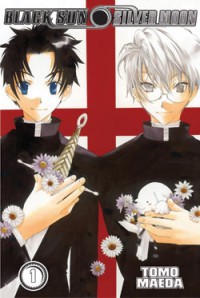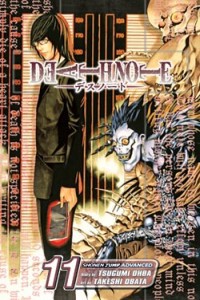RIGHT TURN ONLY!!
Are You There Shinigami? It's Me, Kira
by Carlo Santos,

As if there weren't already enough ways to geek out over Nodame Cantabile, I picked up the Nintendo DS game a couple of weeks ago, and am now happily tapping along with classical music's greatest hits. I may never have the chops to actually play Rachmaninov's 2nd Piano Concerto, but I can sure help to keep the beat.
Oh, and the PuriGorota game wins for all time.
BLACK SUN SILVER MOON

Vol. 1
(by Tomo Maeda, Go!Comi, $10.99)
FROM THE BACK COVER:
"Taki thought he was getting just what he needed; a nice, quiet job to pay off his late father's debts. Instead, he got priest Shikimi, who orders him to cleanse the church of all impurities—including the zombies! Suddenly forced into the role of maid by day and demon-hunter by night, Taki's about to find out what other secrets Shikimi has been hiding behind his silver eyes and calm, calculating smile..."
EVIDENCE FOR:
Don't let story summaries fool you. Although it sounds like a supernatural adventure at first, Black Sun Silver Moon actually brings a slice-of-life flavor to the world of undead-slaying. Killing zombies isn't nearly as important as the complicated friendship between Taki and Shikimi, who disagree about every little (and big) thing even as their lives depend on each other. As you might expect, then, the stories in this volume have a bittersweet feel to them, focusing on the worries of being different, and how we reach out to others in order to cope. Even the side story after the main series takes on that theme, albeit in a more fairytale-like setting. This kind of thoughtful, heartwarming storytelling proves that even in alternate worlds, people still have the same fears and hopes. Delicate linework and design reinforce that contemplative mood, and the layouts are all about expressing emotion through sprawling panels and drifting backgrounds. Perhaps we could all take a moment to sit back and think about our own struggles through life.
EVIDENCE AGAINST:
There is nothing going on in this story. Really. The premise is a memorable one, and it does set up an intriguing friendship, but there's no progress from that point on. Once Taki gets the hang of slaying the undead, he and Shikimi basically hang out for the next hundred-odd pages. They even spend an entire chapter dealing with a pet dog! It doesn't matter if the genre is fantasy-supernatural or slice-of-life or somewhere in between—doggie tales are no way to get the plot moving. The characters themselves also have a dampening effect on the story: Taki and Shikimi just don't have enough conflict to make things interesting. Sure, they bicker over chores and argue about the meaning of life, but it feels more like a couple of college roommates shooting the breeze, rather than a true conflict of ideals. This kind of blandness is also evident in the washed-out, shoujo-generic art that's been toned and grayed in every area possible. Slaying zombies, raising dogs, chatting about life—after a while, it all just starts to look the same.
FINAL VERDICT:
It could have been a strong idea. It could have been about the sacrifices we make to protect our lives and the lives of others. But no, the main guys in this series are just faking their way through with a C.
DEATH NOTE

Vol. 11
(by Tsugumi Ohba and Takeshi Obata, Viz Media, $7.99)
FROM THE BACK COVER:
"Light Yagami is an ace student with great prospects—and he's bored out of his mind. But all that changes when he finds the Death Note, a notebook dropped by a rogue Shinigami death god. Any human whose name is written in the notebook dies, and Light has vowed to use the power of the Death Note to rid the world of evil. But will Light's noble goal succeed, or will the Death Note turn him into the very thing he fights against?
Light's latest machinations are putting a strain on even his formidable intellect as Near flies to Japan to beard Kira in his den. Near is sure that Light is Kira, but his sense of honor as L's heir will allow no doubts. He doesn't want to just stop the Kira murders, he wants to expose Light as the Death Note killer. Light thinks he's up to the challenge, but will the pressures of his fiancée, his new flame, and his acolyte prove to be fatal distractions?"
EVIDENCE FOR:
Chapter after chapter, Death Note has always been dead serious—but this latest volume might just make you laugh. Secondary characters steal the show this time around, with "the girls of Death Note" (broadcaster Takada and Kira-turned-idol Misa) getting into a hilariously catty love rivalry over Light. Meanwhile, the police force's Matsuda keeps it real with his gossipy commentary; seriously, the only reason this guy is still alive is because he's too clueless to be dangerous. As for the actual story, this is some of the tightest plotting we've seen in the past few volumes: the focus is entirely on Light vs. Near, and it's a hypnotic experience watching them try to out-guess each other. Heck, this could be the most intense mental battle since the days of L. Naturally, much of that intensity comes through the stark, high-contrast art, especially with the characters' facial expressions. Nobody does an "Aha!" face quite like Light ... unless it's Misa, whose evil grins are pure comedic genius.
EVIDENCE AGAINST:
So is this what Death Note has become—a celebrity love triangle and people making funny faces? What a disappointment for a series just one volume away from the end. This one is clearly playing for time, especially in the penultimate chapter, where several pages go by without a single word. "Whiling away the hours" indeed ... and no one is better at that than Near, who's still making sloppy assumptions all the way to the end. He even admits his own impulsiveness, apparently quite content to be a false shadow of L. In fact, the plotting in general is getting sloppy, with certain characters being shoved out of the way for convenience. This idea works just fine until people suddenly remember, "Oh yeah, whatever happened to so-and-so?" Not only are characters going missing, but also the action, the shinigami, and that whole horror-thriller edge the series once had. Could Death Note actually be ... dying?
FINAL VERDICT:
Something is definitely screwy when the secondary characters are more interesting than the main cast. But let's be nice and give it a B for entertainment value and wacky Misa.
HAYATE THE COMBAT BUTLER

Vol. 3
(by Kenjiro Hata, Viz Media, $9.99)
FROM THE BACK COVER:
"Since the tender age of nine, Hayate Ayasaki has busted his behind at various part-time jobs to support his degenerate gambler parents. And how do they repay their son's selfless generosity? By selling his organs to the yakuza to cover their debts! But fate throws Hayate a bone ... sort of.
As if dealing with his mistress Nagi's outlandish demands weren't taxing enough, poor (yet perennially hardworking) Hayate has to suffer the ignominy of being challenged to a duel by Nagi's fiancé, Wataru Tachibana. With his saber at the ready, Hayate is prepared to defend himself ... but is there any logical reason why he's fighting a duel in the first place? Shouldn't the simple act of keeping the Sanzenin household spic-and-span be enough?"
EVIDENCE FOR:
If there's one thing you can count on in Hayate, it's a bona fide theater of the absurd, where anything and everything is fair game for mockery. Kenjiro Hata's love of mainstream anime and gaming pops up frequently (is it just me or does that giant robot in the later chapters look awfully ... evangelic?), and it's nice to see some pop culture gags that are actually popular for once. Of course, this isn't the series' only source of humor: miscommunication between characters sets off plenty of funny reactions, Hayate's self-esteem issues are both endearing and amusing, and when in doubt, there's always the fourth wall. When the characters start poking fun at their own series, well, that's a whole new dimension right there. The short chapters lend themselves naturally to sitcom-style plotting, and that's when the comedy works best—rich brats trying to understand how a subway works, for example, or Hayate and Wataru fighting it out over Isumi's shawl. Truly, nothing says funny like taking mundane ideas and elevating them to sublime levels of silliness.
EVIDENCE AGAINST:
Sorry, but elevating mundane things to levels of silliness is about the only thing Hayate does right. Despite some clever gags, it doesn't deliver them with enough energy, instead just trudging from joke to joke and waiting for Hayate or Nagi or Wataru to make the next cutting remark. And that's assuming the joke worked in the first place—let's face it, references to "Gund*m" get tired after about the fifth time, and it's always a hit-or-miss game when it comes to name-dropping and non sequiturs. If the humor isn't clicking with you, get ready for a very boring story, especially since the underlying plot was already illogical in the first place, and when it takes a dramatic turn in the second half, things just get even duller. More crazy gags, less love-triangle action, please. Don't expect anything special with the art, either, which is as ordinary as it gets and in some cases even looks disproportioned. Here's an artist who draws just well enough to get by, and hopes to high heaven that the humor can carry him. Unfortunately, hope is no substitute for talent.
FINAL VERDICT:
Good for a laugh or two, but with no real story or visual flair to carry it, it's just an average comedy on the level of a C.
MILLENNIUM SNOW

Vol. 1
(by Bisco Hatori, Viz Media, $8.99)
FROM THE BACK COVER:
"Seventeen-year-old Chiyuki Matsuoka was born with heart problems, and her doctors say she won't live to see the next snow. Toya is an 18-year-old vampire who hates blood and refuses to make the traditional partnership with a human, whose life-giving blood would keep them both alive for a thousand years.
Chiyuki makes the most of the time she has left, even though things aren't that exciting—until she comes across a reluctant vampire late one chilly night. Can Chiyuki teach Toya to feel passion for life, even as her own is ending?"
EVIDENCE FOR:
I know, I know, you're all rolling your eyes and groaning, "Not another vampire story." But Bisco Hatori is not the kind to simply rehash an old premise. Once she gets past introducing the main characters, the focus is less about the vampire "image" (blood, nobility, hot guys in fancy outfits) and more about the conflict of ideals between Chiyuki and Toya. She's living every moment like it's her last; he's got all the time in the world—how will these two ever reconcile their views on the value of life? The addition of a rival male character midway through brings in yet another strong personality; ultimately, the story becomes a question of how different people with different maladies choose to live their lives. It's strong, philosophical stuff, and certainly a lot more interesting than the same old let's-go-hunt-vampires-and-kill-them-dead twaddle. Amidst all the seriousness is a sprinkling of Ouran-esque humor as well, and Hatori's stylish penwork is an eye-pleasing blend of action and emotion. Oh, and don't miss the side story in the back—it's another supernatural romance that packs a poignant punch, and does it in just 40 pages.
EVIDENCE AGAINST:
Let's not kid ourselves here. For all its psychobabble about the value of life, Millennium Snow is still just another story about a hot vampire guy who hooks up with an innocent, lily-hearted girl. True, it does introduce some potentially deep ideas, but it never builds on these ideas—instead, it's stuck on Philosophy Lite, where everyone gets to feel smart because they were only thinking about the implications of eternal life, without moving on to any further intellectual challenges. In fact, by about Chapter 3 or so, Chiyuki and Toya's relationship is basically a hamster wheel of opposing emotions where he acts all tortured and despairing while she tries to be optimistic and kindhearted. Repeat as many times as needed. Don't know about you guys, but that sure sounds like a rehash of an old premise, and one that capitalizes on the vampire image too. Also, beware of vague page layouts that don't so much flow from panel to panel as just ... wandering there, waiting for you to guess which scene comes next.
FINAL VERDICT:
It could have been better ... an intriguing idea that just doesn't follow through, and ends up being a typical high school vampire romance ranked at C+.
ROZEN MAIDEN

Vol. 4
(by Peach-Pit, Tokyopop, $9.99)
FROM THE BACK COVER:
"Jun is back surfing the 'Net, looking for clues about Shinku's arm and what he saw in his dream. But the closer he comes to finding answers, the more he learns about a twisted world of revenge and deception between two brothers. He finds Souseiseki's master, who is ready to take her back if she promises to help find the person responsible for his brother's death. But is history as he remembers it? His own delusion may cost the Rozen Maiden dolls dearly."
EVIDENCE FOR:
So you wanna know when it gets good? Well, Rozen Maiden's already been getting good, but Volume 4 hits a true high point, bringing drama, action and fantasy all together. The story of Souseiseki's master is loaded with regret and heartbreak, perhaps even deeper than one would have ever expected from a series about a boy and his walking, talking dolls. Throw some magical warfare and personal sacrifice on top of that, and it's the perfect setup for some serious physical and emotional damage. Once again Jun shows real growth as a character, and just to throw a screw into the works, a certain doll who's been hiding out the past few chapters makes a comeback! Just know this: Peach-Pit always finds a way to fire you up. Yet in the same breath, they can also make you laugh, with nuggets of comedy gold like Hinaichigo's quest to mail a thank-you note, a new doll's attempts to infiltrate the house, and, well, anything that comes out of Suiseiseki's mouth. And the artwork, although technically imperfect, has proven its worth—the raw and evocative style suits the dreamlike spaces that the characters often move through. Sketchy lines blended with flowery designs create a Rozen Maiden world that sits just on the edge of reality, if not also on the edges of our imagination.
EVIDENCE AGAINST:
Stepping into that dreamworld, however, means easily getting lost. Vague dialogue and wandering layouts will often demand a second or third re-reading, just to figure out what the heck is going on. Even the pivotal moment—a change of heart from Souseiseki's master—seems to come out of nowhere, despite the old man trying to explain it with his thoughts. And if it's not lack of clarity, it's lack of story; the next arc after this one is a couple of chapters flailing about in search of a plot. Yes, living-doll comedy can keep the series afloat for a little while, but there needs to be a serious "And THEN what happened?" after the Souseiseki incident or else it'll quickly get pointless. We demand satisfaction, not hanging subplots! Unfortunately, hanging subplots is all you'll have to settle for in the later stages of this volume, where Suigintoh hangs out with a hospital girl, Souseiseki's fate lies in limbo and a new doll tries to break into the house but never even mentions her name. If the story doesn't pull itself together next volume, then "It gets good" is quickly going to become "Then it gets lame."
FINAL VERDICT:
This volume hits a dramatic high point and earns some laughs as well, but the storytelling falters later on, making it about a B-.

GOTHIC SPORTS

Vol. 1
(by Anike Hage, Tokyopop, $9.99)
FROM THE BACK COVER:
"Anya, the new girl at Lucrece High, just isn't fitting in. Her dream is to join one of the school's elite sports teams, but when she gets tries out, she's instantly rejected! Anya doesn't get mad, though—she gets even. When she meets other 'misfits' who've been similarly written off, they form their own soccer team, complete with cool, edgy uniforms. They may not be the most experienced, but they've got something no other team has: style. Say hello to the world's first Gothic-Lolita soccer team!"
EVIDENCE FOR:
Welcome to a world that is at once instantly familiar, and yet just a touch different from everything else out there. Sure, America and Japan have their high school sports stories as well, but the German sensibility of Gothic Sports is something all its own, from the national school system to the way people interact with each other. (Outspoken, but mostly friendly.) You can just tell that the Europeans do things differently, even in Hage's art, which combines the efficiency of seinen layouts with the fluidity of shoujo line, because over there, they don't have any dumb rules about dividing comics by gender. Anya, meanwhile, feels like the perfect balance of an underdog protagonist: opinionated but not obnoxious, high-spirited without parroting that "I'll do my best!" line over and over. The story is a breeze to get into, with a streamlined approach that brings in the characters one by one—first Anya, then a friend, then her rival, then some prospective team members, each with a touch of personality. The plotline may look simple, but there's enough struggle to make it interesting, and the focus remains fixed on one thing: getting the team together and getting to that first match!
EVIDENCE AGAINST:
And as soon as that first match comes ... suddenly it's Volume 2. Whoops. The story is so streamlined, in fact, that it eats up a bunch of pages without anything big really happening, and makes the first volume feel more like an introductory Volume 0. The character designs, too, are a bit too quick-and-easy. They're cute only in a superficial way—and it might take a moment to register that Anya and her rival Marie are, in fact, different people, despite both being girls with long, light-colored hair. The action sequences are also lacking: one look at the basketball scene in Chapter 2 and you may never want to look at it again, with its jerky poses and no flow between panels. Cute characters and cool uniforms are one thing, but anyone doing a sports series had better plan on getting the sports part right. Let's hope Hage can draw a mean game of soccer.
FINAL VERDICT:
The story floats along too lightly, but between the Golden State Warriors knocking off the Dallas Mavericks and the Milwaukee Brewers sitting atop the major leagues, who doesn't love a good underdog sports story?

No Nodame review this week, so sorry! But here's a classical manga which is far more "Mukyaaa?!" than I would have liked. In fact, it might be one of the Worst Manga I've Ever Read:
MOZART DOESN'T SING LULLABIES

Vol. 1
(by Rui Arisugawa, Square-Enix, ¥552)
Maybe it's just me. Maybe I'm so spoiled by stuff like Amadeus and Nodame Cantabile that this 19th-century murder-mystery looks especially pathetic when compared to other classical music stories. Imagine, if you will, a bishounen Beethoven who runs into an 18-year-old girl claiming to be Mozart's illegitimate daughter. Then imagine that this girl is upset because of a controversial piece that's been wrongly attributed to her (in)famous father, and that the guy who published the sheet music is found dead, and that Beethoven's student Carl Czerny (who apparently stepped right out of the pages of Ouran High School Host Club) is awfully interested in the connection between the dead publisher and dead Mozart. Yes, this is all in the story. I swear I am not making this up. Guess who else shows up along the way? A 12-year-old Franz Schubert! Mozart's widow Constanze! Even Mozart's old rival Antonio Salieri, and I think someone owes F. Murray Abraham royalties for using his likeness.
What this all adds up to is a nonsensical Viennese rhapsody of famous composers and dangling plot threads. The only reason anyone would keep reading is in hope that one of the plot threads might get sorted out, but they never do, and by the end of the first volume you've got so many mysteries piled on top of each other that even Conan Edogawa would walk away and say he gives up. Maybe this is supposed to build up suspense or something, but all it does is build up confusion. And it's not like the series is even visually distinctive or anything—those pretty-boy composers could switch with any other male lead in a shoujo series, and the backgrounds are all blindly copied from architectural references. In the end, it's not so much that it's the "worst ever" as it is just "incredibly silly," especially in the context of the late Classical period, and knowing what I know about the real Mozart and his contemporaries. Maybe now I understand how embarrassed the Japanese feel when foreigners take samurai and ninja tales way too seriously.
discuss this in the forum (16 posts) |